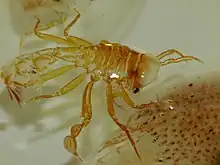| Phronima | |
|---|---|
.jpeg.webp) | |
 | |
| Specimens of Phronima sedentaria | |
| Scientific classification | |
| Domain: | Eukaryota |
| Kingdom: | Animalia |
| Phylum: | Arthropoda |
| Class: | Malacostraca |
| Superorder: | Peracarida |
| Order: | Amphipoda |
| Suborder: | Hyperiidea |
| Family: | Phronimidae |
| Genus: | Phronima Latreille, 1802 |
| Type species | |
| Cancer sedentarius Forsskål, 1775 | |
Phronima is a genus of small, deep sea hyperiid amphipods of the family Phronimidae. It is found throughout the world's oceans, except in polar regions.[1] Phronima species live in the pelagic zone of the deep ocean. Their bodies are semitransparent. Although commonly known as parasites, they are more technically correctly called parasitoids.[2] Instead of constantly feeding on a live host, females attack salps, using their mouths and claws to eat the animal and hollow out its gelatinous shell.[3] Phronima females then enter the barrel and lay their eggs inside, then propel the barrel through the water as the larvae develop, providing them with fresh food and water.[3]
Classification
The genus Phronima contains these species:[4]
- Phronima atlantica [5]
- Phronima bowmani [5]
- Phronima bucephala [5]
- Phronima colletti Bovallius, 1887
- Phronima curvipes Vosseler, 1901
- Phronima dunbari [5]
- Phronima pacifica Streets, 1887
- Phronima sedentaria (Forsskål, 1775) (type species)[1]
- Phronima solitaria Guérin-Méneville, 1836
- Phronima stebbingi Vosseler, 1901
References
- 1 2 James K. Lowry (2003). "Phronimidae". Peracarida : Amphipoda, Cumacea, Mysidacea. Volume 2, Part 2 of Crustacea: Malacostraca in Zoological catalogue of Australia. CSIRO Publishing. pp. 339–344. ISBN 978-0-643-06902-2.
- ↑ Katie O'Dwyer (February 3, 2014). "Meet Phronima, The Barrel-Riding Parasite That Inspired The Movie Alien". Live Science.
- 1 2 Damond Benningfield (June 8, 2008). "Phronima". Science and the Sea. University of Texas Marine Science Institute. Retrieved October 11, 2010.
- ↑ Lowry J (ed.). "Phronima Latreille, 1802". World Amphipoda database. World Register of Marine Species. Retrieved 27 March 2023.
- 1 2 3 4 "Animal Diversity Web". University of Michigan Museum of Zoology.
External links
This article is issued from Wikipedia. The text is licensed under Creative Commons - Attribution - Sharealike. Additional terms may apply for the media files.